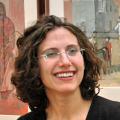Pencil, colored pencil and watercolor on paper
10 x 15 cm
Yad Vashem Art Collection, Moshal Repository
Gift of the artist
"It was between three and four o'clock, the date 11 April 1945. We waited in suspense and with unprecedented tension… Suddenly there were shouts, from the opposite direction, from the main camp… We rushed out to investigate: our compound was lifeless as before. 'Look at the gate!' shouted someone. I lifted my eyes and searched for the pyramid-shaped roof on the main watch-tower that stood out from beyond the main camp. The crooked cross of Fascism had gone. Fluttering from the symbolic flagpole was something white. The moment we had so anxiously been longing for had come: the cherished victorious minute, for which our comrades had been waiting for 4,453 days and nights, was here at last."
In 1956, Thomas Geve gave this description of the moment of liberation from the Buchenwald concentration camp, where he had been transferred during the death marches from Gross-Rosen and Auschwitz. Yet at the time of liberation itself, 15-year-old Thomas chose the medium of drawing in order to document the formative moment of the liberation of Buchenwald by the prisoners. With impressive accuracy, he sketched the figures of the fighting prisoners, the Allied tanks at the entrance to the camp, and the gate on which the flag was replaced. With punctilious detail, he even noted the exact time on the gate’s clock: 3:15 pm. Thomas, whose physical condition did not permit him to leave the camp’s barracks, remained at Block 29 for approximately a month, where he drew this picture and 78 other drawings, each the size of a postcard. In a detailed, almost scientific way, his artwork documents his life as a prisoner at the Auschwitz extermination camp, the death marches, and the moment of liberation from Buchenwald. His stated goal was to share the pictures with his father, who had fled to England just in time. But there is no doubt that these creations also made it possible for him to process the trauma and mentally rehabilitate himself, while at the same time gathering physical strength.
On 27 January 2015, to mark International Holocaust Remembrance Day and 70 years since the liberation of Auschwitz, a special display opened at Yad Vashem's Museum of Holocaust Art in the presence of Israel's Prime Minister Benjamin Netanyahu and survivor-artist Thomas Geve. The exhibit, entitled "The Anguish of Liberation as Reflected in Art, 1945-1947," includes 30 pictures and drawings by almost 20 artists all from Yad Vashem's Art Collection.
Surprisingly, a comprehensive examination of post-liberation artwork indicates that, in contrast to Geve and liberators such as Zinovii Tolkatchev, who marked the event themselves, most of the survivor-artists did not commemorate Liberation Day itself – the moment they longed for throughout the war – focusing instead on other subjects. Thus, the diverse post-liberation work of survivors can be divided into five main categories: references to freedom; documenting the ruin and destruction; searching for identity; coping with trauma; and, to a lesser degree, the day of liberation.
Some of the artists returned to the places where they had grown up, searching for home or hoping to find relatives. However, instead of the old familiar world in which they had hoped to rehabilitate themselves, they found only ruin and devastation. Henryk Hechtkopf documented postwar Warsaw in a series of drawings that he created from 1945-1946. His beloved hometown appears totally destroyed, strewn with piles of rubble, and its main streets resemble a ghost town of desolate structures. Yet these apocalyptic sights do not just document the destruction caused in the wake of the bombings. Rather, they also disclose the artist’s inner feelings, finding in the chaos outside expression for his personal suffering and existential turmoil.
These difficult feelings also appear in the survivors’ self-portraits. Thus, Halina Olomucki, a young 26-year-old survivor of Auschwitz, draws the lines of her face like those of an old woman, revealing her unstable mental state with the lines of a quivering pencil. Ilka Gedő from Budapest, two years younger than Halina, presents herself with no head, with skewed and frail shoulders, and hands wracked with pain.
The young Yehuda Bacon finds a renewed faith in humanity and life in general in the figure of the educator Pitter Přemysl. Přemysl, who saved Jews during the Holocaust and was eventually recognized as Righteous Among the Nations, also tended to the needs and rehabilitation of children who survived the war, including young Bacon. Like Orpheus leaving the underworld, Bacon depicts himself bent over and led by Přemysl from the darkness of the camps to the light of life awaiting him in Eretz Israel.
For Jakob Zim, who, like Thomas Geve, was liberated from Buchenwald, the meaning of liberation lay in the ability to discern beauty even in the accursed landscape of the village near the camp, and in the renewed freedom to paint. In this time of crisis and destruction the possibility of having an aesthetic experience while giving voice to it in the conscious act of painting is a testament to the vast powers of the mind. Ultimately, the survivors’ desire to create, to express pain, reflection, emotion and perception through art reveals their fierce will to live in spite of everything. For them, choosing to paint is like choosing life, or in Jakob Zim’s words: “I live with the shadow and create with the light.”
First published in Yad Vashem Jerusalem magazine, #76, February 2015





